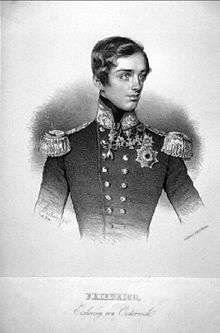Archduke Friedrich of Austria (1821–1847)

Archduke Friedrich Ferdinand Leopold of Austria (German: Erzherzog Friedrich Ferdinand Leopold von Österreich) (14 May 1821 – 5 October 1847) was a member of the House of Habsburg and Commander-in-Chief of the Austrian Navy.
Family
Friedrich was the third son of Field Marshal Archduke Charles of Austria (1771–1847) and Princess Henrietta of Nassau-Weilburg (1797–1829). He never married and did not leave issue.
Military career in the Navy
Born in Vienna, Friedrich joined the Imperial Austrian Navy in 1837 at the age of sixteen. He threw himself into this career with much zeal and quickly rose to command a ship, sailing to the orient for the first time in 1839.
Oriental Crisis of 1840
During the Oriental Crisis of 1840 between Egypt and the Ottoman Empire, Friedrich fought in the campaign against Muhammad Ali after the Convention of London. He served with the Austrian fleet off the Levantine coast as commander of the ship Guerriera.
In that convention, the United Kingdom, Austria, Prussia, and Russia had offered Muhammad Ali hereditary rule of Egypt as part of the Ottoman Empire if he withdrew from the Syrian hinterland and the coast of Mount Lebanon. Muhammad Ali hesitated until British naval forces moved against Syria and Alexandria.[1] After the British and Austrian navies blockaded the Nile delta coastline, shelled Beirut (on September 11, 1840), and after Acre had surrendered (on November 3, 1840), Muhammad Ali agreed to the terms of the Convention on November 27, 1840.[2]
From his ship Friedrich directed the assault on the citadels of Sidon and Beirut which soon fell. Following the bombardment of Acre on November 3, 1840 he personally led a small landing party of Austrian, British and Ottoman Turkish troops and took the citadel of Acre after the Egyptian garrison had fled. They hoisted the Turkish, British and Austrian flags over the citadel. For his exceptional leadership during the campaign he was appointed Knight of the Military Order of Maria Theresa.
Commander-in-Chief
In 1842 Friedrich sailed to Algeria and England. In 1844 he was promoted to the rank of Vice Admiral and took office as Commander-in-Chief of the Imperial Austrian Navy at the age of twenty-three. His appointment came after a mutiny by Venetian junior officers led by the sons of admiral Baron Francesco Bandiera.
As Commander-in-Chief, Friedrich introduced many modernising reforms, aiming to make his country's naval force less "Venetian" but more "Austrian". In Austria there had until the end of the eighteenth century only been limited attempts at establishing a navy of its own. When the Habsburgs received the city of Venice along with Istria and Dalmatia following the Treaty of Campo Formio in 1797, this situation was changed considerably. The Venetian naval forces and facilities were handed over to Austria and became the basis of the formation of the future Austrian Navy. Until Friedrich's term as Commander-in-Chief it was however often felt that the force officially styled the "Austrian Navy" was in practice little more than Venetian crews and ships sailing under the Austrian flag.
Friedrich had a keen private interest in the fleet, and with him the Austrian naval force gained its first influential supporter from the ranks of the Imperial Family. This was crucial as sea power was never a priority of the Austrian foreign policy and the navy itself was relatively little known or supported by the public. It was only able to draw significant public attention and funds during the three short periods of its history when it was actively supported by an imperial prince. Following Friedrich's example, the archdukes Ferdinand Maximilian (1832–1867) and Franz Ferdinand (1863–1914) would later become active campaigners for naval matters.
Death
Friedrich's term as Commander-in-Chief of the Imperial Austrian Navy was cut short. He died of jaundice in Venice at the age of twenty-six, only three years after taking office. Some boats have been named for him including a large sailboat SMS Erzherzog Friedrich and the battleship SMS Erzherzog Friedrich (1902).
Notes
Further reading
Dauber, Robert L. Erzherzog Friedrich von Österreich: Admiral und Ordensritter. Graz: Styria, 1993. ISBN 3-222-12218-0.
Ancestry
| ||||||||||||||||||||||||||||||||||||||||||||||||||||||||||||||||||||||||||||||||||
| Wikimedia Commons has media related to Archduke Friedrich Ferdinand of Austria. |
|
.svg.png)
